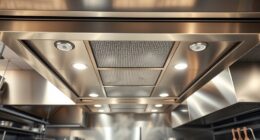To reduce pollutant infiltration, you should combine properly maintained air curtains with a well-designed vestibule. Regular maintenance guarantees the air curtain works effectively, blocking dust, pollen, and fumes, while a vestibule acts as a buffer zone that minimizes outdoor air entry. Proper sealing, automatic doors, and durable flooring boost performance and indoor air quality. For best results, integrating these strategies creates a stronger barrier against pollutants, enhancing comfort and health—you’ll discover more techniques ahead.
Key Takeaways
- Proper maintenance of air curtains ensures effective sealing and consistent airflow, reducing pollutant entry.
- Well-designed vestibules act as buffer zones, trapping outdoor contaminants before they reach indoor spaces.
- Automatic or delayed door closures in vestibules minimize air exchange and pollutant infiltration during traffic flow.
- Combining air curtains with sealed vestibules enhances pollutant barriers, improving indoor air quality.
- Regular inspections and strategic vestibule design optimize system performance, lowering infiltration of dust, pollen, and fumes.

Have you ever wondered how buildings keep out pollutants and drafts when doors are frequently open? The answer often lies in the strategic use of air curtains and thoughtfully designed vestibules. These solutions serve as effective barriers that prevent unwanted air exchange, helping maintain indoor air quality and energy efficiency. But to maximize their benefits, you need to pay attention to air curtain maintenance and vestibule design considerations.
Proper air curtain maintenance is essential. Over time, dirt, dust, or mechanical issues can impair their performance, reducing their ability to create a consistent seal against outside contaminants. Regular inspections ensure the air flow remains strong and uniform, and filters are clean, preventing blockages that could strain the system. When you keep up with maintenance, the air curtain continues to act as a reliable barrier, reducing infiltration of pollutants like dust, pollen, and exhaust fumes. Neglecting this upkeep, however, risks compromised air quality and increased energy costs due to drafts and temperature fluctuations. Scheduling routine check-ups and promptly addressing repairs keeps your air curtain functioning at peak efficiency. Additionally, monitoring airflow rates using quick‑calculators can help ensure optimal performance.
In addition to maintenance, paying attention to vestibule design considerations markedly enhances pollutant control. A well-designed vestibule acts as a buffer zone, allowing people to transition between the outdoors and indoors without directly exposing the interior environment to outside air. You should consider factors such as the size and shape of the vestibule, ensuring it’s large enough to accommodate traffic without congestion. Doors should be properly aligned and equipped with automatic or delayed closing mechanisms to minimize air exchange when not in use. Flooring materials that are durable and easy to clean help prevent dirt and debris from being tracked inside. Additionally, incorporating proper sealing around doors and windows limits gaps where pollutants could infiltrate. When you design with these considerations in mind, you create an effective first line of defense that complements the air curtain, trapping pollutants at the threshold before they reach the interior.
Integrating regular air curtain maintenance with thoughtful vestibule design creates a cohesive system that effectively reduces pollutant infiltration. This combination not only improves indoor air quality but also enhances energy efficiency by maintaining consistent indoor temperatures. When you prioritize these aspects, you ensure that your building remains a healthier, more comfortable environment for everyone inside. Ultimately, paying attention to both maintenance and design considerations allows you to harness the full potential of air curtains and vestibules, creating a resilient barrier against outside pollutants even during busy hours when doors are frequently open.
Frequently Asked Questions
How Do Air Curtains Differ From Traditional Doors?
Air curtains differ from traditional doors by creating a seamless barrier that improves air curtain efficiency, preventing pollutants from entering while allowing easy access. Unlike doors, they don’t require physical opening and closing, reducing energy loss. In a door insulation comparison, air curtains often outperform traditional doors by maintaining better temperature control and reducing infiltration. You’ll find them ideal for maintaining indoor air quality without sacrificing convenience or energy efficiency.
What Maintenance Is Required for Vestibules?
Ever wonder how to keep your vestibules functioning properly? You should regularly inspect door sealants for wear and tear, ensuring they remain effective in preventing drafts. Follow specific cleaning protocols to keep glass and surfaces clear of dirt and debris, which maintains visibility and hygiene. Do you check these components often? Proper maintenance not only extends your vestibules’ lifespan but also optimizes their ability to reduce pollutant infiltration effectively.
Can Air Curtains Be Used Outdoors Effectively?
Yes, you can use air curtains outdoors effectively, especially if you consider outdoor airflow and weather resilience. Choose models designed for exterior use that can withstand wind, rain, and temperature fluctuations. Proper installation is key to guarantee the air curtain creates a reliable barrier against dust, insects, and pollutants. Regular maintenance and weather-resistant features will help keep the system functioning at its best, providing a consistent indoor environment despite outdoor conditions.
Are There Environmental Benefits Beyond Pollutant Reduction?
Using air curtains and vestibules offers environmental benefits beyond pollutant reduction. They improve indoor air quality by preventing drafts and outdoor contaminants from entering, creating a healthier environment. Additionally, they boost energy efficiency by maintaining indoor temperatures, reducing the load on heating and cooling systems. This combination helps lower energy consumption, decreases greenhouse gas emissions, and supports sustainability efforts, making your building more eco-friendly and cost-effective in the long run.
What Are the Initial Costs of Installing Vestibules?
You’re getting a clear picture of the initial costs for vestibule installation, which typically depends on factors like size, materials, and complexity. The cost estimation can range widely, but it’s worth noting that it’s an upfront investment that pays off by reducing energy loss and pollutants. While it might seem like throwing money into the wind at first, proper planning guarantees you get the best bang for your buck and smooth installation.
Conclusion
Just like the guardians of ancient gates, air curtains and vestibules stand at your door, defending your space from unwanted pollutants. By choosing to implement these barriers, you take control—protecting indoor air quality and ensuring a healthier environment. Remember, every fortress begins with a single step; your decision today echoes the wisdom of those who understood that strength lies in thoughtful defenses. Embrace these tools, and keep your space a sanctuary against unseen intruders.









